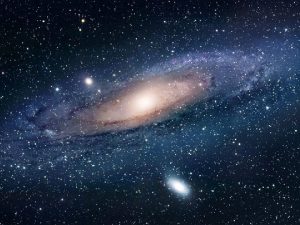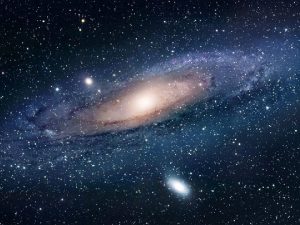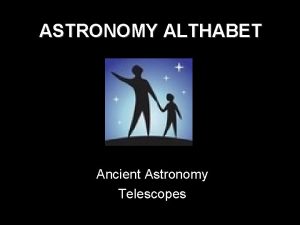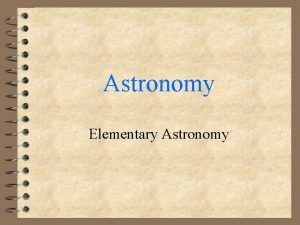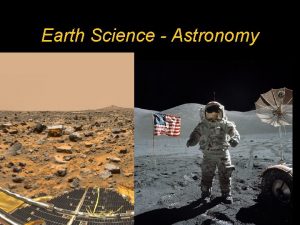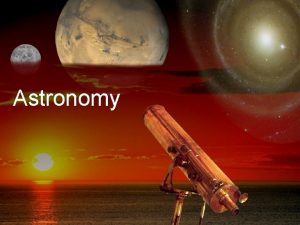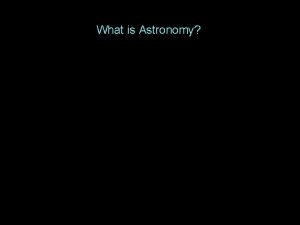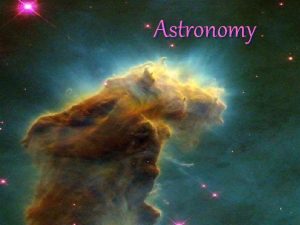Astronomy What is Astronomy 1 Astronomy is the
















- Slides: 16

Astronomy

What is Astronomy? 1. Astronomy is the study of the universe. • This includes planets, stars, galaxies, black holes, moons, meteors, comets, asteroids and all of the matter that exists in space. 2. Astronomers are people who observe and study space.

Modern Calendar 1. Our modern calendar is based on the observations of bodies in our solar system. 2. A year is the time it takes for the Earth to orbit the sun. 3. A month is the time it takes for the moon to orbit the Earth. 4. A day is the time it takes for the Earth to rotate once on its axis.

The Size and Scale of our Universe 1. It is important to consider scale when we think about the universe. 2. Stars appear to be very small when viewed from Earth, but they are actually very large, some, like our sun, are bigger than Earth.

The Scale of our Solar System Earth

Scale of the Universe SUN Mercury

Our Galaxy and Scale • Our Milky Way galaxy is simply huge. Just how big is our galaxy? • Let's now pretend that our galaxy is a kid's sandbox, and our sun is a grain of sand in a sandbox. • The Earth is a miniscule dust speck near the grain of sand, too small to be seen without a microscope. • If our sun were a grain of sand in this sandbox representing the Milky Way galaxy, the sandbox would be somewhat oval and yet flat, and would be about 20 feet in diameter. • The sand would be about 12 inches thick in the center, and thinner towards the edges.

Milky Way Galaxy

Distance in Space 1. Distance in space is measured in light years. 2. A light year is used to measure large differences in space. 3. A light year is the distance light travels in a year, 5. 88 trillion miles. 4. Light travels at 186, 000 miles per second.

THE MILKY WAY GALAXY • Each swirling object you see is a galaxy in our universe. 1. We can estimate that there about 100 billion stars in our galaxy. 2. Andromeda is the nearest major galaxy to our own Milky Way Galaxy. 3. Most scientists believe that Andromeda is about 2 million light years away from the Milky Way.

What is a Galaxy? 1. A large group of stars, gas, and dust held together by gravitational attraction. 2. A system of about 100 billion stars. 3. There are billions of galaxies in the observable universe.

3 Types of Galaxies n 1. Spiral n 2. Elliptical n 3. Irregular

Spiral Galaxy 1. Spiral galaxies consist of a flat, rotating disk of stars, gas and dust, and a central concentration of stars known as the bulge. 2. The Milky Way galaxy is a spiral galaxy.

Irregular Galaxy 1. These are galaxies that feature neither spiral nor elliptical morphology. 2. They are often chaotic in appearance, with neither a nuclear bulge nor any trace of spiral arm structure.

Elliptical Galaxy 1. Elliptical galaxies have smooth, featureless lightprofiles. 2. There is very little interstellar matter (neither gas nor dust), which results in low rates of star formation. 3. Elliptical galaxies are dominated by old stellar populations, or old stars.

FLASHCARDS FOR THIS PPT PRESENTATION http: //www. flashcardmachine. com/180371/x 18 g
 Learning astronomy by doing astronomy activity 1 answers
Learning astronomy by doing astronomy activity 1 answers Learning astronomy by doing astronomy
Learning astronomy by doing astronomy Learning astronomy by doing astronomy
Learning astronomy by doing astronomy Vẽ hình chiếu vuông góc của vật thể sau
Vẽ hình chiếu vuông góc của vật thể sau 101012 bằng
101012 bằng Công thức tính thế năng
Công thức tính thế năng Tỉ lệ cơ thể trẻ em
Tỉ lệ cơ thể trẻ em Thế nào là mạng điện lắp đặt kiểu nổi
Thế nào là mạng điện lắp đặt kiểu nổi Lời thề hippocrates
Lời thề hippocrates Vẽ hình chiếu đứng bằng cạnh của vật thể
Vẽ hình chiếu đứng bằng cạnh của vật thể đại từ thay thế
đại từ thay thế Quá trình desamine hóa có thể tạo ra
Quá trình desamine hóa có thể tạo ra Các môn thể thao bắt đầu bằng tiếng đua
Các môn thể thao bắt đầu bằng tiếng đua Hình ảnh bộ gõ cơ thể búng tay
Hình ảnh bộ gõ cơ thể búng tay Khi nào hổ mẹ dạy hổ con săn mồi
Khi nào hổ mẹ dạy hổ con săn mồi Các loại đột biến cấu trúc nhiễm sắc thể
Các loại đột biến cấu trúc nhiễm sắc thể Nguyên nhân của sự mỏi cơ sinh 8
Nguyên nhân của sự mỏi cơ sinh 8





















